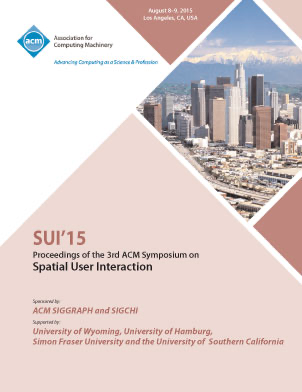
3rd Symposium on Spatial User Interaction 2015 Proceedings
Evan Suma, Frank Steinicke, Wolfgang Stuerzlinger
Abstract:
It is our great pleasure to welcome you to the third ACM Symposium on Spatial User Interaction. This event focuses on the user interface challenges that appear when users interact in the space where the flat, two-dimensional, digital world meets the volumetric, physical, three-dimensional (3D) space we live in. The symposium considers both spatial input as well as output, with an emphasis on the issues around the interaction between humans and systems. Due to the advances in 3D technologies, spatial interaction is now more relevant than ever. Powerful graphics engines and high-resolution screens are now ubiquitous in everyday devices, such as tablets and mobile phones. Moreover, new forms of input, such as multi-touch, finger and body tracking technologies are now easily available, and more and more commercial 3D systems with spatial interaction capabilities exist, many priced at the consumer level. However, the challenges, limitations, and advantages of leveraging this third dimension in human-computer interfaces are still not yet fully understood. These questions will only become more relevant as these emerging technologies continue to cross the barrier towards wide adoption.
The call for papers attracted 48 submissions from Asia, Europe, Australia, and North and South America in all areas of Spatial User Interaction research. The international program committee consisting of 19 experts in the topic areas and the three program chairs handled the review process. Eight submissions were reviewed by the program chairs and rejected without further review due to being incomplete, insufficient quality, or inappropriate for the symposium topic. All other submissions received at least four detailed reviews, two from members of the international program committee and two or more from external reviewers. The reviewing process was double-blind, with the authors' identities visible only to the program chairs and the primary program committee member assigned to the paper. In the end, the program committee accepted 17 papers (10 long, 7 short), corresponding to an overall acceptance rate of 35%. Additionally, 11 posters complement the program and appear in the proceedings. Furthermore, three research demonstrations were accepted and will be presented at the symposium. We also encourage attendees to attend the keynote talk, TRANSFORM: Beyond Tangible Bits, Towards Radical Atoms, presented by Hiroshi Ishii from the MIT Media Lab.
